Effective Strategies for Controlling Carpenter Ants


Intro
Carpenter ants, known for their destructive habits, often go unnoticed until significant damage is done. These pests are not just a nuisance; they threaten the integrity of homes. Understanding how to identify and control carpenter ants is essential for homeowners who want to protect their investments. The key to effective pest management lies in a thorough grasp of their behavior, signs of infestation, and proven strategies for treatment and prevention. This guide will arm you with detailed knowledge, making it easier to tackle these unwelcome guests efficiently.
Pest Identification
Detailed Descriptions of Common Pests
Carpenter ants are typically large, black, or bicolored insects, often reaching lengths of 0.25 to 1.5 inches. Unlike termites, carpenter ants boast a smooth body with a pinched waist. Their mandibles are strong, allowing them to chew through wood, which they carve out for nest building. Two common species include the black carpenter ant, prevalent in many regions, and the red carpenter ant, often found in wooded areas.
Understanding their physical traits helps homeowners distinguish them easily from other insects.
Signs and Symptoms of Infestations
Recognizing the signs of a carpenter ant infestation early on can save you from experiencing more significant issues down the line. Here are some telltale signs:
- Wood Shavings: If you notice small, sawdust-like particles near wood surfaces, these could be from the carpenter ants tunneling through timber.
- Frass: This term refers to the debris produced as ants excavate wood. It may look like fine wood shavings and can be found around nesting sites.
- Nocturnal Activity: Carpenter ants are mostly active at night. If you spot them wandering around after dark, it’s a red flag.
- Rustling Sounds: If you hear faint noises within your walls, this could indicate a colony at work.
"Ant infestations often go unnoticed until they are deep-rooted; regular checks are crucial to intercepting these pests early."
Prevention Strategies
Home Maintenance Tips for Pest Prevention
Preventing carpenter ants from entering your home requires vigilant upkeep. Implementing a few simple maintenance tips can make a significant difference:
- Seal Cracks and Openings: Check your foundation and walls for any gaps. Seal them to block possible entry points.
- Keep Wood and Mulch Dry: Carpenter ants thrive in moisture. Ensure that wood piles are stored away from the house and that your mulch is not too thick next to your foundations.
- Regular Inspections: Regularly assess your home for signs of pests and potential problem areas.
- Reduce Attractants: Keep your home clean, free from food debris. Ants are constantly foraging for food, so managing waste is essential.
Natural Deterrents and Barriers
For those who prefer chemical-free solutions, various natural deterrents can help to keep carpenter ants at bay:
- Diatomaceous Earth: This natural powder can be spread around entry points. It’s harmless to humans and pets but lethal to insects.
- Vinegar Solution: A mixture of vinegar and water can be sprayed on areas where you’ve spotted ants. The smell disrupts their scent trails.
- Essential Oils: Scents like peppermint and tea tree oil can act as effective barriers. Mixing them with water and spraying them around potential entry points can deter ants.
Treatment Options
Overview of Chemical vs. Natural Treatments
When faced with an infestation, homeowners often weigh the pros and cons of chemical versus natural treatments. Chemical treatments can be very effective and may provide quick results, but they come with their own risks and considerations. Natural treatments, while often slower-acting, are typically safer for your family and pets. Identifying the scale of infestation usually dictates the choice of treatment.
Step-by-Step Guides for DIY Treatments
If you're inclined to tackle the issue on your own, here’s a simple approach:
- Locate the Nest: Use the signs mentioned previously to find the nest.
- Apply Diatomaceous Earth: Sprinkle it around the nest and entry points.
- Bait: Set out baits containing boric acid. The ants carry it back to the nest, effectively targeting the colony.
- Monitor: Observe the treated areas for activity over the following weeks. Persistence in treatment is key.
Always remember that successful control of carpenter ants requires an ongoing commitment to monitoring and management. With the right strategies in place, you can create a more pest-resistant home environment.
Understanding Carpenter Ants
Understanding carpenter ants is crucial for any homeowner or pest control enthusiast. These persistent pests have a knack for wreaking havoc in homes, particularly in wooden structures. Gaining insight into their behavior and biology not only helps in identifying an infestation but also in implementing effective control methods. A deep dive into their life cycle, nesting habits, and physical features lays the groundwork for effective management and preventative approaches.
Biology of Carpenter Ants
Physical characteristics
Carpenter ants are known for their striking size, often measuring between ¼ to ½ inch in length. Their physical features include a robust body, with a distinctly segmented appearance and large mandibles. One key characteristic is their coloration, which varies widely among species, ranging from black to reddish or even orange hues. This variability can make it challenging to identify them accurately, yet it's essential for any control efforts.
A fascinating aspect of their physicality is their wings during certain life stages, notably in reproductive individuals. The presence of winged carpenter ants can alarm homeowners, as it often signifies that a nearby nest is thriving. Understanding these features helps in recognizing an invasion before it's too late. Homeowners should be aware that these impressive ants can do a number on wooden structures, as their strong mandibles enable them to tunnel through wood with ease, weakening support beams and pillars over time.
Colony structure
Carpenter ant colonies exhibit a sophisticated social structure. Typically, a single colony can contain thousands of ants, structured into a hierarchy comprised of workers, soldiers, and a queen. This colony structure is advantageous for both survival and reproduction. The presence of specialized worker ants ensures that tasks such as foraging, nursing the young, and maintaining the nest are managed efficiently.
A notable feature of carpenter ant colonies is their ability to create satellite nests, often in multiple locations. This adaptability causes challenges for pest control, as one may treat a visible infestation without realizing that others exist elsewhere. Homeowners must consider this to effectively combat the problem. Furthermore, understanding the dynamics of their colony structure illuminates why they are so resilient in the face of control efforts.
Life cycle
Carpenter ants undergo a complex life cycle that includes several stages: egg, larva, pupa, and adult. The entire life cycle from egg to adult can take several weeks to months, depending on environmental conditions. Understanding this timeline is essential for implementing effective control measures at the right time. For example, treatments should prioritize areas being actively used by the adult ants and larvae.
A unique aspect of their life cycle involves the swarming phase, which typically occurs in the spring. During swarming, winged males and females leave the colony to mate and establish new nests. This phase serves as a crucial opportunity for homeowners to identify potential new colonies on the verge of setting up shop in their homes. Awareness of these life stages promotes timely interventions that can impede further infestations.
Behavioral Traits
Nesting habits
Carpenter ants favor moist, decaying wood where they can build intricate nests. Common locations include tree stumps, wooden decks, and even the structural wood of buildings. This affinity for decayed wood is highly significant; it is where they feel safest and can thrive without much disturbance.
One interesting characteristic of their nesting habits is their tendency to form multiple nest sites. This trait is beneficial, as it provides redundancy so that if one nest is disturbed, the colony can continue operating from another. Homeowners should be mindful of these potential locations around their property, as proactive inspections can stave off bigger issues down the road.
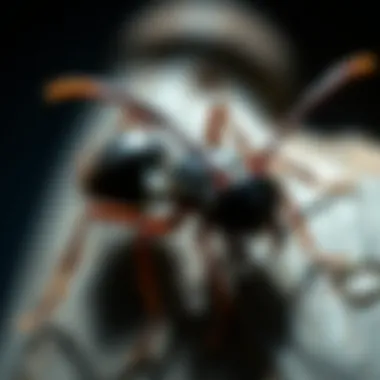
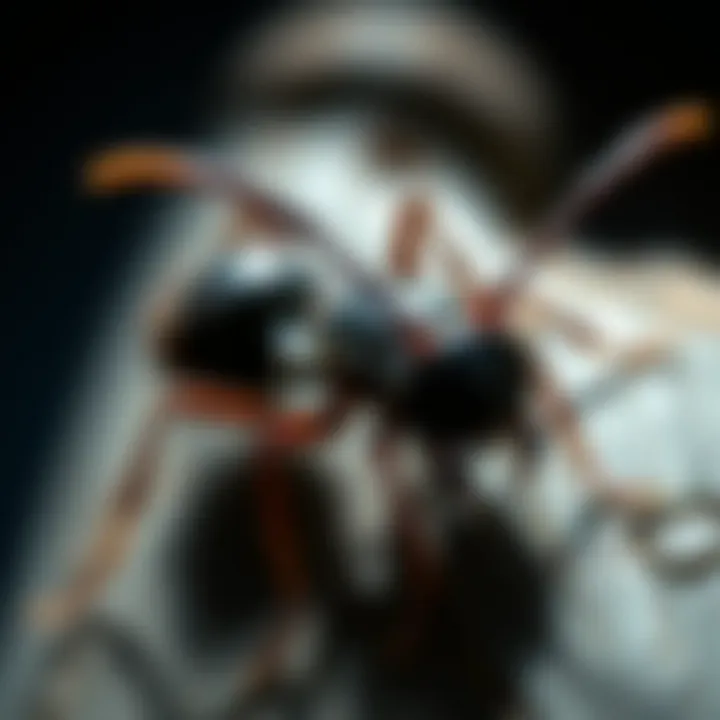
Foraging patterns
Carpenter ants are opportunistic foragers, often traveling long distances in search of sustenance. Their diet primarily consists of proteins and sugars, which they gather from both natural sources and human food supplies. This behavior may not only lead to damage to wooden structures but also cause nuisances within homes.
A key observation regarding their foraging patterns is their ability to recruit others to food sources through pheromones. This characteristic heightens the level of infestation quickly, as one discovery can result in a swarm of ants appearing seemingly overnight. Homeowners can combat this by being vigilant about food storage and clean-up practices.
Communication
Carpenter ants communicate primarily through chemical signals known as pheromones. This method facilitates the transmission of crucial information, such as food locations and alarm signals within the colony. Their sophisticated communication aids in the efficiency of colony tasks and survival tactics.
Another unique feature of their communication system involves the occasional use of sound, produced by stridulating their mandibles. This sonic signaling can serve multiple purposes, such as rallying workers or signaling distress. Understanding these communication methods can provide insight into the dynamics of their behavior, thereby equipping homeowners with knowledge to observe and recognize increased activity or possible infestations in their living spaces.
Overall, mastering the biological and behavioral traits of carpenter ants sets the stage for effective control strategies and long-term prevention. By appreciating their complexities, homeowners can act more strategically in their pest management efforts.
Identifying Carpenter Ant Infestations
Recognizing an infestation of carpenter ants early on is crucial to mitigate significant damage. Not only do they hollow out wood to create nests, but they can also cause structural issues in homes and buildings. Thus, understanding the key signs of their presence becomes vital for homeowners. Identifying an infestation allows for prompt action, and the sooner you act, the more effective your intervention will be. A comprehensive exploration of how to spot these wood-loving critters can save both time and money.
Signs of Infestation
Wood shavings and frass
Wood shavings, often described as a fine powdery substance, are a clear indicator of carpenter ant activity. When these ants excavate wood, they leave behind a trail of shavings mixed with their droppings, known as frass. This material can be found near the entrance holes the ants create in wood. It’s essential for homeowners to be vigilant for such signs as they often lead to discovering hidden infestations. A characteristic of the frass is its resemblance to sawdust but it may also have a wood grain appearance; this detailed observation can help differentiate them from merely discarded tree debris.
Advantages: Identifying wood shavings and frass means you can track the location of the infestation. The presence of this debris is quite noticeable and helps you gauge the severity of the situation. If you find a significant amount, it may signal deeper infestations into structural supports.
Sound of rustling
The sound of rustling can often go unnoticed, but it is another crucial sign of potential carpenter ant activity. When disturbed, carpenter ants may create audible sounds within the walls or wooden areas of your home. This might initially seem eerie, but it is a practical clue; it signals that there is movement and activity behind those surfaces. Listening carefully, especially during quiet moments, can help you discern these sounds from electrical or plumbing systems.
Advantages: Utilizing your sense of hearing in conjunction with other signs can lead to quicker identification of infestations. While rustling may not guarantee the presence of carpenter ants, it definitely warrants further investigation, especially if accompanied by the presence of frass.
Presence of winged ants
When carpenter ants swarm, it is often a sign that a colony has matured and is seeking to establish new nests. These winged ants can be spotted around windows or doors during certain times of year, typically spring and early summer. Recognizing their distinctive physical characteristics, like the smooth cuticle and segmented body, aids in proper identification. The emergence of winged ants indicates that the colony is thriving, and their presence suggests that the problem has escalated.
Advantages: Spotting winged ants early can provide homeowners with a clear signal to take action before the situation worsens. Their appearance is often fleeting, so fast recognition can lead to better chances for effective treatment.
Common Locations for Nests
Trees and stumps
Carpenter ants prefer to nest in decayed or damaged wood, making trees and stumps prime locations for their colonies. However, just because a tree looks healthy doesn’t mean it’s not harboring an infestation. Ants are known to exploit soft spots in trees to create nests, which often leads to further damage. If you have trees on your property, regular inspection of these areas is crucial.
Advantages: By focusing on outdoor nests in trees or stumps, homeowners can develop preventive measures before ants migrate into structures. Identifying these nesting sites can also inform your pest control strategies, guiding where to apply treatments.
Structural wood
Many infestations start right in the house, particularly in structural wood like beams, walls, or flooring. Areas that are less visible, often behind drywall or under siding, can be hotbeds for carpenter ant activity. Carpenter ants prefer to tunnel into wood that is moist or rotting, so regular checks on the condition of your home’s structural elements matter.
Advantages: Understanding where to look can help homeowners act promptly. If you suspect an infestation in structural wood, it allows for swift intervention, possibly preventing costly repairs down the line.
Wall voids
Wall voids are another common nesting site for carpenter ants, often overlooked during routine inspections. These confined spaces provide an ideal habitat for ants to thrive and often go undetected until populations explode. Ants can access these voids through cracks or gaps, making them difficult to pinpoint.
Advantages: Recognizing the potential of wall voids for hideouts means you can adjust your inspection strategies. Addressing potential entry points around the home can help reduce the chances of a nest forming here.
Each of these indicators, whether it’s wood shavings or the presence of winged ants, plays a critical role in identifying carpenter ant infestations. Being proactive and knowledgeable about these signs empowers homeowners to take quicker action and develop effective strategies to control these pests.
Natural Methods of Control
Natural methods of controlling carpenter ants are crucial for homeowners who prefer eco-friendly techniques while tackling these pests. Not only do they minimize the use of harsh chemicals, but they also contribute to the environment's well-being. Utilizing natural methods allows for a balance between effective ant management and preservation of home and health.
Adopting a natural approach can also prove beneficial in preventing future infestations. This section will cover essential oils, boric acid, and diatomaceous earth—three popular natural solutions that can help keep carpenter ants at bay while ensuring the safety of your household.
Essential Oils
Essential oils have gained popularity as an effective deterrent against carpenter ants. Their natural properties offer valuable contributions to pest control strategies preemptively.
Peppermint
Peppermint oil is known for its strong scent that ants find repulsive. Its high menthol content acts almost like a natural barricade against these pests. What makes peppermint especially advantageous is its dual property; while repelling ants, it leaves your space smelling fresh and inviting.
However, the effectiveness of peppermint oil diminishes over time and may require periodic reapplication to maintain its potency. Be aware that while it can help deter ants, severe infestations might require additional methods to complement its use.
Lemon oil
Lemon oil is another noteworthy mention when discussing deterrents against carpenter ants. Its acidic nature disrupts the ants' pheromone trails, which are vital for navigation. By erasing these trails, lemon oil makes it tough for ants to find their way back to their nests.
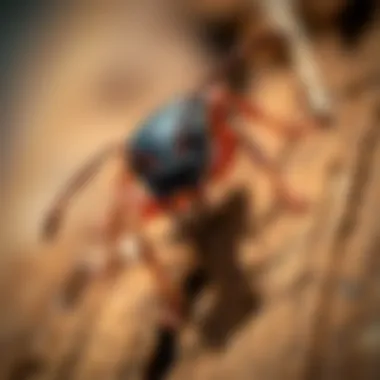
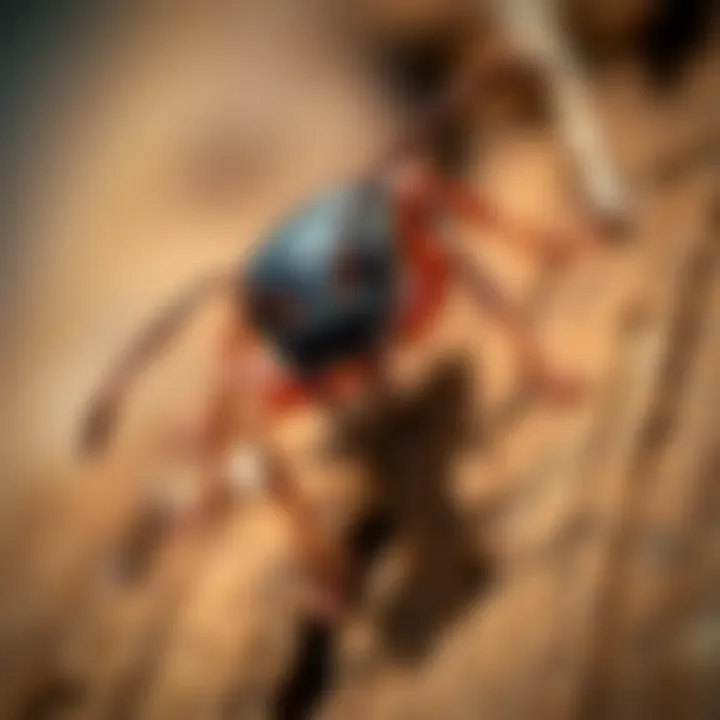
The refreshing fragrance of lemon oil is a bonus, as it can lend a pleasant aroma to your home. On the downside, like peppermint, lemon oil might not solve a major pest problem on its own and might best serve as a supplementary method when used alongside other strategies.
Clove oil
Clove oil, derived from the clove plant's buds, offers both antimicrobial and insecticidal properties. Ants are often deterred by strong scents, and clove oil manages to pack a punch in this regard. It can effectively disrupt their foraging behavior, encouraging them to retreat.
The one catch with clove oil is its potency; a little goes a long way. Overuse can lead to undesirable odors in the home that linger longer than expected. So moderation is key when applying it to combat those pesky carpenter ants.
Boric Acid
Boric acid is a versatile option in the fight against carpenter ants. Its method of action revolves around the slow-acting toxicity that draws ants in. When they ingest it, boric acid disrupts their digestive systems, eventually leading to their demise.
How it works
Boric acid works by creating a harmful environment for carpenter ants without immediate effects. This slow-release mechanism is strategically beneficial, as it allows for ants to return to their colony and share the toxic substance, thus affecting more ants in the process.
While this strategy might take time to show results, it often leads to a more thorough eradication of the problem in colonies. One must ensure to keep boric acid away from pets and children, as safety becomes a concern with its use.
Application methods
Boric acid can be conveniently used in several ways. One can mix it with sugar or a honey solution, creating an attractive bait for the ants. This easy-to-use method maximizes the chances of ants consuming the boric acid while being drawn to the sweetness.
However, always remember to place bait stations in hidden areas, ensuring they are away from places pets or children can reach. Additionally, regular monitoring of these stations is advised to ensure effectiveness over time.
Safety considerations
Safety cannot be overlooked when using boric acid. While it is considered less harmful than many synthetic pesticides, caution is still necessary. Keep it out of reach of children and pets, and wash your hands thoroughly after use. Following the manufacturer's instructions and taking precautions can help leverage its advantages without compromising safety.
Diatomaceous Earth
Diatomaceous earth (DE) serves an interesting role in pest control; its properties are often overlooked by homeowners.
Mechanism of action
Diatomaceous earth works on a more physical level rather than chemical. The fine powder is made from fossilized algae, and when insects come into contact with it, DE damages their exoskeletons, leading to dehydration. This method is non-toxic and safe for humans and pets, which emphasizes its appeal.
Though the process doesn't yield immediate results like some chemical solutions, it can prove effective over time. When applied properly, it can create a long-lasting barrier against ants trying to invade your space.
Best practices for application
When applying diatomaceous earth, it's best to ensure that areas are clean and dry for optimal effectiveness. Applying a light dusting in crevices, around entry points, or in areas where you've spotted ant activity will work wonders.
However, be careful not to oversaturate; a thin layer is all that’s necessary. Additionally, consider reapplying after heavy rain or cleaning to maintain its deterrent effect.
Effectiveness
The effectiveness of diatomaceous earth can vary based on its quality and application method. It may take time to see results, as the slow-but-sure approach is characteristic of this method. Many users find it worthwhile, especially considering its safety profile.
While not the quickest option in the shed, DE holds substantial long-term value against carpenter ants when used appropriately. Thorough knowledge about application and maintenance can pay off, keeping your home ant-free naturally.
Chemical Control Options
Chemical control methods play a crucial role in managing carpenter ant populations, especially when natural approaches fall short. Often, dealing with an infestation requires a more aggressive strategy. Chemical options can be particularly effective for quick results or when the presence of carpenter ants poses immediate risks to a structure.
When utilizing chemical control, it’s important to understand the various tools at your disposal. These options not only help eradicate visible pests but also disrupt the colony as a whole, ensuring that you’re addressing the source of the problem rather than merely the symptoms.
Insecticidal Sprays
Types of sprays
Insecticidal sprays specifically formulated for carpenter ants come in a range of types, each with its unique mechanism of action. For example, pyrethroid-based sprays are popular for their rapid knockdown ability, which effectively kills ants on contact. Alternatives like neonicotinoids offer lasting residual effects, which is beneficial for keeping ant populations at bay over an extended period.
- Key Characteristics: The fast action of these sprays makes them appealing to homeowners needing immediate relief from ants.
- Benefits: A unique feature of these sprays is their ability to affect not just foraging ants but also those inside the nest, gradually leading to nest elimination. However, the downside includes potential harm to beneficial insects, emphasizing cautious usage.
Application techniques
Effective application techniques can dramatically enhance the efficacy of insecticidal sprays. A targeted approach focusing on areas where ant activity is evident ensures that the method is both efficient and economical.
- Key Characteristics: Techniques can include spot treatment directly on trails or nests, or a broader application to create a protective barrier around a property.
- Advantages: Targeted applications minimize waste and reduce the likelihood of impacting non-target species.
- Disadvantages: However, improper application may lead to ants avoiding treated areas or even moving to untreated spaces within the home.
Safety precautions
When working with insecticidal sprays, safety is paramount. It's vital to follow label directions carefully, using personal protective equipment like gloves and masks to prevent exposure.
- Key Characteristics: Using these sprays in line with manufacturer guidelines protects both the user and the environment.
- Benefits: A well-executed safety protocol enhances the overall effectiveness of treatment by minimizing the risk of harm to humans and pets.
- Disadvantages: Lax safety measures can lead to unintended consequences, such as health risks or contamination of food sources.
Baiting Systems
Types of baits
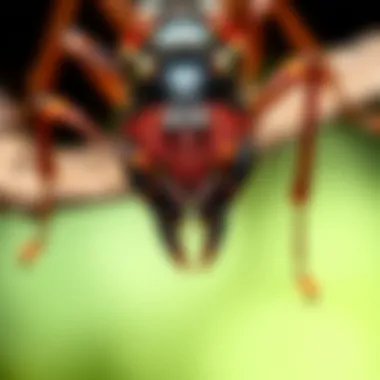
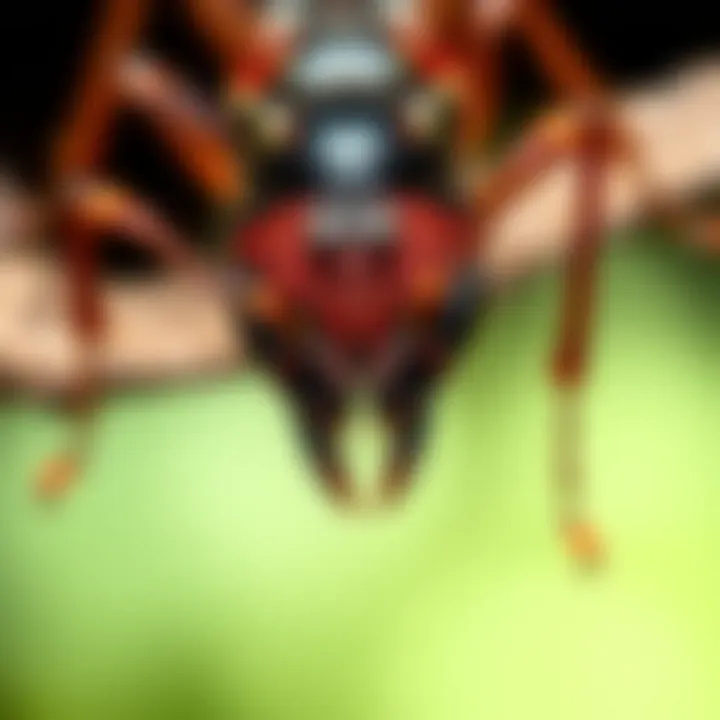
Baiting systems offer a strategic method in the fight against carpenter ants. Various types of baits, including liquid and solid forms, cater to different feeding preferences among ant species.
- Key Characteristics: Liquid baits tend to attract carpenter ants effectively because of their sugar-water base, while protein-based baits are useful for colonies focusing on brood care.
- Benefits: The main advantage of these baits is that they rely on the ant's foraging behavior, where foraging ants take the bait back to the nest, eventually killing the queen and the rest of the colony.
- Disadvantages: Nevertheless, baits may take a longer time to show results compared to sprays, which might frustrate some homeowners undergoing immediate threats.
Placement strategies
Successful baiting necessitates strategic placement. Identifying high-traffic areas where ants regularly forage is essential.
- Key Characteristics: Baits should be placed close to nests, but not too close to the immediate sources of food to avoid competition.
- Benefits: Timely and relevant placement significantly increases the chances of foraging ants accessing the bait quickly.
- Disadvantages: Improper placement or moving baits too frequently can lead to reduced efficacy, as ants may become wary or miss them entirely.
Monitoring efficacy
Monitoring the effectiveness of baiting systems is crucial. Homeowners should regularly check bait stations to see if they are being utilized.
- Key Characteristics: The rise in ant activity around baits indicates that effectiveness is present.
- Benefits: Keeping on top of bait efficacy allows adjustments in bait type or placement before it gets out of hand.
- Disadvantages: However, dependency on baits can lead to complacency, where homeowners underestimate the need for follow-up treatments or other preventative measures.
Understanding the unique benefits and limitations of chemical control options provides a well-rounded approach to effectively manage carpenter ant infestations. Combining these strategies with a broader Integrated Pest Management plan can deliver the best results in protecting your home.
Integrated Pest Management
Integrated Pest Management (IPM) is a cornerstone approach for efficiently dealing with carpenter ants and ensuring long-term control. The essence of IPM lies in the combination of various methods and strategies that contribute to sustainable pest management. Rather than relying solely on chemicals, IPM encompasses a broader perspective, integrating natural methods, monitoring, and physical interventions. This holistic strategy not only targets the immediate symptoms—like the presence of ants—but also addresses underlying conditions that foster infestations.
One of the significant benefits of IPM is its versatility. Homeowners can choose different tactics based on the severity of the situation and their individual comfort levels with various methods. For instance, if the issue is minor, natural methods like essential oils might suffice. However, in more severe cases, a blend of chemical and non-chemical approaches might be necessary to fully eradicate the problem.
"Effective pest control isn’t just about which spray to use; it’s about understanding the whole system at play."
The considerations around implementing IPM include understanding the specific species of carpenter ants you are dealing with, their behavior, and how they interact with the environment. Monitoring and evaluation play a crucial role here, as they help assess the success of the chosen methods.
Combining Methods
Natural versus chemical methods
The core of IPM is the combination of natural versus chemical methods in controlling carpenter ants. Natural methods—like essential oils and boric acid—are increasingly becoming a popular choice as they pose fewer risks to humans and pets. They also tend to be environmentally friendly, aligning well with many homeowners’ desires to reduce their chemical footprint. However, their effectiveness can vary based on infestation severity and the specific environment.
On the other hand, chemical methods include insecticidal sprays and baiting systems. While these can be incredibly effective, they are often seen with skepticism due to potential health risks and environmental concerns. The unique feature here is the immediacy of results that chemicals can provide, but they often don’t address the root causes of the infestation, leading to possible re-infestation down the road.
Timing of applications
Timing is a crucial aspect of pest management. In IPM, understanding the lifecycle of carpenter ants and the peak periods of their activity is essential. For instance, applying treatments during their foraging phase can significantly increase effectiveness. The main advantage of proper timing is that it maximizes the chances of successful control while minimizing the amount of product needed, which ultimately is a more cost-effective solution.
Well-timed applications can help in catching the ants just when they are vulnerable, reducing the overall population quicker and more efficiently. Conversely, if applications are mistimed, it can lead to wasted resources and prolonged infestations.
Evaluation of success
Evaluating success in an IPM approach involves ongoing monitoring and assessment of the situation post-treatment. This process is important as it allows homeowners to see if the methods employed are actually working. An important characteristic of this evaluation is the use of clear, measurable indicators such as decreased activity of ants or a reduction in visible signs of infestation.
Regular evaluations can help in tweaking methods if the first round of solutions doesn’t yield the expected results. However, the evaluation process may take time to show results, which could be a downside for those seeking immediate resolution. Still, this reflective practice is essential to truly understand the dynamics at play and to ensure that the same mistakes aren’t repeated in the future.
Long-term Prevention Strategies
Environmental modifications
Environmental modifications can play a vital role in the long-term prevention of carpenter ant infestations. This involves making changes to the home and surrounding landscape to eliminate factors that attract carpenter ants. A characteristic feature of this approach is that it creates an inhospitable environment for the pests, emphasizing how they thrive in damp or decaying wood.
By addressing these factors—like fixing leaky pipes and removing rotting wood—homeowners can significantly reduce the risk of infestations. The main advantage here is that it requires minimal ongoing effort once established, leading to a more sustainable lifestyle.
Regular inspections
Conducting regular inspections is another smart strategy for preventing carpenter ant problems before they spiral out of control. This proactive measure allows homeowners to catch signs of future infestations early. The key characteristic here is that regularity breeds familiarity with what to look for. Spotting early indicators—like small trails of wood shavings or intermittent ant sightings—enables swift action.
While inspections may demand time and some diligence, the benefits of catching issues early often far outweigh the costs of a full-blown infestation.
Public awareness
Lastly, fostering public awareness around carpenter ants and their management can empower entire communities to work together against these pests. Education about the importance of prevention and early response is crucial. By sharing experiences and successful strategies, homeowners can create a more informed society that prioritizes pest management.
This increased awareness can lead to collective action in neighborhoods, making it harder for carpenter ants to find suitable habitats. The downside might be that not everyone may be receptive or proactive about these strategies, particularly in cases where the threat seems remote or insignificant.
Overall, integrating these strategies into a comprehensive plan arms homeowners with the knowledge and tools they need to manage and prevent carpenter ant infestations effectively.
End
Controlling carpenter ants effectively is more than just a passing concern for homeowners; it’s a critical need that requires ongoing attention and a blend of strategies. This article emphasizes the paramount importance of understanding not just the ants themselves, but also their habitual patterns and nesting preferences. A well-rounded approach leads to timely detection and eradication which ultimately saves structural integrity and minimizes costs associated with late intervention.
Summary of Key Points
- Understanding Biology and Behavior: Gaining insight into the biology and behavioral traits of carpenter ants helps in pinpointing their hotspots and potential entry points.
- Effective Identification: Recognizing the signs of infestation—like wood shavings and rustling sounds—enables quicker remedial actions.
- Control Methods: Both natural and chemical methods offer unique benefits. Essential oils may be favored for natural preferences, while insecticidal sprays can deliver robust solutions quickly.
- Integrated Pest Management: Combining various strategies leads to more success than relying on a single method. This approach encompasses natural and chemical interventions, ensuring comprehensive control.
These key points reflect a full picture of the carpenter ant challenge, reminding homeowners that awareness and proactive measures are essential to keeping infestations at bay.
Importance of Ongoing Monitoring
Maintaining vigilant oversight on your home’s condition is absolutely essential in preventing carpenter ant re-infestation. With their tendency to return, constant monitoring can't be overstated. Keeping an eye on common nesting areas—such as moisture-rich wood or hollow structures—will enable early detection of potential threats. Furthermore, regular inspections and maintenance stop nests from taking root before they become a significant concern.
Monitoring doesn’t just stop at the physical inspection. It can also involve community awareness as neighborhood interactions can reveal trends in pest issues, alerting you to potential problems.



